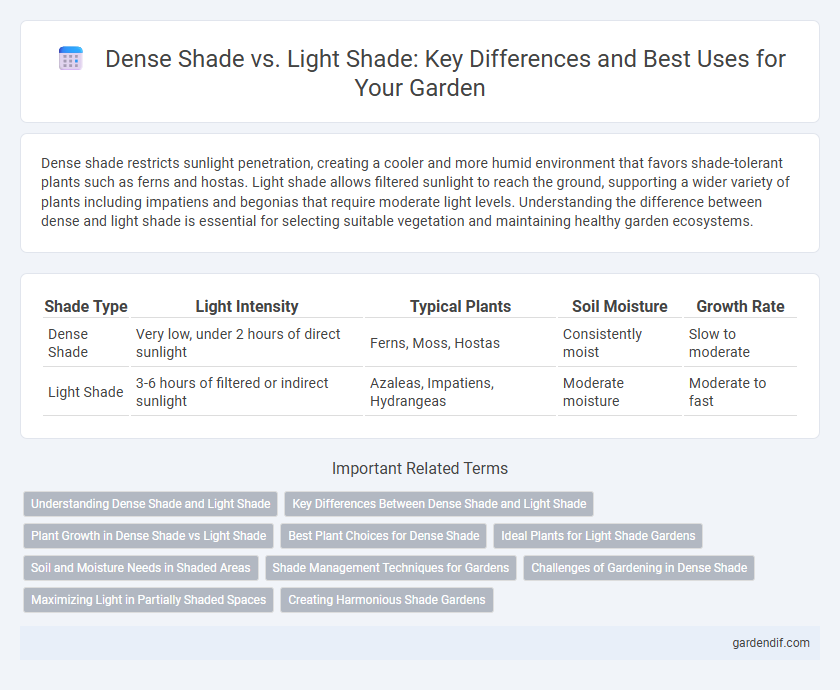
Dense Shade vs Light Shade Illustration
Dense shade restricts sunlight penetration, creating a cooler and more humid environment that favors shade-tolerant plants such as ferns and hostas. Light shade allows filtered sunlight to reach the ground, supporting a wider variety of plants including impatiens and begonias that require moderate light levels. Understanding the difference between dense and light shade is essential for selecting suitable vegetation and maintaining healthy garden ecosystems.
Table of Comparison
| Shade Type | Light Intensity | Typical Plants | Soil Moisture | Growth Rate |
|---|---|---|---|---|
| Dense Shade | Very low, under 2 hours of direct sunlight | Ferns, Moss, Hostas | Consistently moist | Slow to moderate |
| Light Shade | 3-6 hours of filtered or indirect sunlight | Azaleas, Impatiens, Hydrangeas | Moderate moisture | Moderate to fast |
Understanding Dense Shade and Light Shade
Dense shade occurs when sunlight is significantly obstructed by thick foliage or structures, resulting in minimal light penetration and cooler, damper conditions ideal for shade-loving plants like ferns and hostas. Light shade allows intermittent or filtered sunlight, providing sufficient energy for a broader range of plants such as impatiens and begonias, which require some direct or dappled light to thrive. Understanding the distinction between dense and light shade is crucial for selecting the appropriate plant species and ensuring healthy garden growth.
Key Differences Between Dense Shade and Light Shade
Dense shade occurs under thick, overlapping canopy layers that block most sunlight, significantly reducing photosynthesis and plant growth. Light shade allows filtered or dappled sunlight to penetrate, supporting a wider variety of shade-tolerant plants and improving plant health. Understanding these differences is crucial for selecting appropriate vegetation and managing garden microclimates effectively.
Plant Growth in Dense Shade vs Light Shade
Dense shade limits sunlight penetration, significantly reducing photosynthesis and stunting plant growth, resulting in weaker stems and smaller leaves. Plants in light shade still receive partial sunlight, supporting moderate photosynthesis that fosters healthier growth and better flowering compared to dense shade conditions. Selecting shade-tolerant species optimized for partial light environments improves growth performance in light shade over dense shade.
Best Plant Choices for Dense Shade
Dense shade requires plants that thrive with minimal sunlight, such as ferns, hostas, and astilbes, which excel in low-light conditions and maintain vibrant foliage. Best plant choices for dense shade include shade-tolerant perennials like Solomon's seal and bleeding heart, known for their adaptability and ornamental value. Selecting species with broad leaves enables optimal photosynthesis in dim environments, ensuring healthy growth and garden aesthetics.
Ideal Plants for Light Shade Gardens
Ideal plants for light shade gardens include hostas, ferns, and astilbes, which thrive in areas receiving filtered sunlight or partial shade. These plants are adapted to lower light levels but still require enough indirect light to maintain vibrant foliage and blooms. Choosing species like hellebores and bleeding hearts ensures healthy growth and adds color to gardens with dappled sunlight.
Soil and Moisture Needs in Shaded Areas
Dense shade areas typically have limited sunlight penetration, resulting in cooler soil temperatures and higher moisture retention, which reduces the need for frequent watering but demands well-draining soil to prevent root rot. Light shade zones receive filtered sunlight that warms the soil moderately, promoting faster evaporation and requiring soil with good water-holding capacity to sustain plant hydration. Understanding these differences in soil moisture dynamics helps optimize irrigation schedules and soil amendments for healthy plant growth in shaded environments.
Shade Management Techniques for Gardens
Dense shade restricts sunlight significantly, leading to slower plant growth and the need for shade-tolerant species like ferns and hostas, while light shade allows more filtered sunlight, supporting a broader variety of plants such as begonias and impatiens. Effective shade management techniques for gardens include strategic pruning to increase light penetration, using reflective surfaces to enhance ambient light, and selecting shade-adapted mulch materials to retain soil moisture. Incorporating raised beds or containers can also improve soil drainage and root exposure, optimizing plant health under varying shade conditions.
Challenges of Gardening in Dense Shade
Gardening in dense shade presents challenges such as limited sunlight penetration, which inhibits photosynthesis and reduces plant growth vigor. Many common garden plants struggle to survive or bloom in low-light environments, leading to sparse foliage and weak root development. Selecting shade-tolerant species like ferns, hostas, and certain begonias is essential to overcoming the constraints of dense shade conditions.
Maximizing Light in Partially Shaded Spaces
Dense shade limits photosynthesis by significantly reducing sunlight penetration, causing slower plant growth and requiring shade-tolerant species with low light needs. Light shade allows filtered or dappled sunlight, supporting a wider variety of plants by maximizing available light intensity and duration. Optimizing light in partially shaded areas involves strategic placement of plants, reflective surfaces, and pruning to increase light exposure while minimizing stress from excessive shade.
Creating Harmonious Shade Gardens
Dense shade, characterized by minimal sunlight due to thick tree canopies or solid structures, demands shade-tolerant plants such as ferns, hostas, and astilbes that thrive in low-light conditions. Light shade offers partial sunlight, creating an ideal environment for a wider variety of plants including impatiens, begonias, and hydrangeas, which balance shade with some direct sun exposure. Designing harmonious shade gardens involves selecting plants suited to the specific light level, ensuring healthy growth and visual appeal through texture, color contrasts, and layered planting strategies.
Dense Shade vs Light Shade Infographic

 gardendif.com
gardendif.com